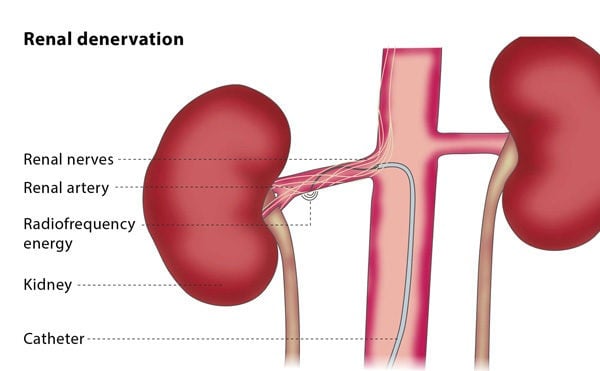The interventional radiologist will insert a catheter into the femoral artery in your thigh, and through this will access the arteries feeding your kidneys. During the RDN procedure, radiofrequency pulses are applied, burning the nerves in the walls of the renal arteries.
The aim of the procedure is to burn the renal nerves without damaging the arteries. Each application of radiofrequency ablation will last for around 1-2 minutes, though this depends on the device used. The interventional radiologist may use a catheter (tube) radiofrequency generator, which requires more than one application of the radiofrequency pulse during the session, or a radiofrequency balloon generator, which requires a single application of radiofrequency pulse.
Why perform it?
This procedure is designed for patients who suffer from resistant hypertension, i.e. those who have already unsuccessfully tried a regimen of at least three medications to treat hypertension at the same time.
In order to be suitable for this procedure, you will need to have strong and healthy veins.
What are the risks?
As RDN is a relatively new procedure, little is known about its long-term effects. However, it has been shown to be an effective treatment for resistant hypertension.
There are a number of risks associated with the procedure. Some patients experience bradycardia (slow heart rate) during the procedure. If this happens, you will be given atropine.
The radiofrequency ablation may cause changes to the wall of the arteries, which can sometimes lead to renal artery stenosis (the narrowing of the renal arteries). This condition can be treated by inserting a stent (a metal mesh tube.)
The imaging used during the procedure also has a number of risks. Bruising can occur to the punctured site at the top of the thigh. Other possible complications include pseudoaneurysm (a bruise caused by a leaking hole in an artery) and tearing in the renal arteries.
Bibliography
1. Staico R, Armaganijan L, Moreira D, et al. Renal sympathetic denervation and ventricular arrhythmias: a case of electrical storm with multiplerenal arteries. EuroIntervention. 2013 Nov 8.
2. Moss J, Vorwerk D, Belli AM, Peregrin J, Lee M, Reekers J. Cardiovascular and Interventional Radiological Society of Europe (CIRSE) Position Statement on Renal Denervation for Resistant Hypertension. Cardiovasc Intervent Radiol. 2013 Nov 13.
3. Thukkani AK, Bhatt DL. Renal denervation therapy for hypertension. Circulation. 2013 Nov 12; 128(20):2251-4.

